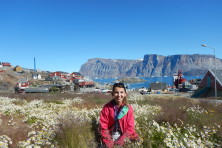Diminishing Ice on the Arctic Sea and Honeybees
- Share
- Tweet
- Pin
- Share
• Tardigrades are tiny invertebrate animals that are so unusual they have been assigned to a special phylum with no other animals in it. “Tardigrade” literally means “slow walker.” These animals are about as large as the period at the end of this sentence, but under a microscope, they look like sausages with eight stubby legs that move them slowly along through mosses, lichens, and leaf litter. What makes they so unusual is that they are virtually indestructible. They are unfazed by temperature up to 302 degrees F or by temperatures as low as minus 328 F. When their habitat dries up, they lose moisture and form dust-like spheres that can be blown about by the wind. When these spheres, called “tuns,” land in a favorable area, the encysted tardigrade soaks up moisture and once again becomes an eight legged creature, feeding on detritus and other vegetation in their new surroundings. When tardigrades were sent into space to expose them to solar heat, radiation, and the vacuum of space, they returned to earth unaffected. In a nuclear war, tardigrades and cockroaches may be among the few survivors. (New Scientist, Sept. – Oct., 2011)
• The Arctic Sea ice has diminished by 40 percent since 1979. Mark Serreze, director of the National Snow and Ice Data Center, said “We may be looking at an Arctic Ocean essentially free of summer ice only a few decades from now.” Research by Jennifer Frances of Rutgers University shows that severe ice loss can slow down the jet stream winds that affect much of our weather. This will likely result in droughts, heat waves, and even extended cold spells in various parts of the planet. She and Russian researchers also believe it is likely that loss of summer ice covering the Arctic Ocean will lead to enormous releases of methane from the Arctic Ocean seabed, which will hasten the rate of climate change since methane is 20 times more efficient than carbon dioxide in its effect on global warming. Giant plumes of methane have already been seen over parts of the warming arctic. (Sierra Magazine, Mar/April, 2012; Igor Semiletov of the Russian Academy of Sciences, interview in http://www.independent.co.uk; other sources)
• Honeybee populations are currently threatened by a combination of factors that lead to what has been termed “colony collapse.” This is a serious situation, for these bees pollinate everything from garden flowers to multi-million dollar agricultural crops. Mites and a kind of virus or fungus have been implicated in colony collapse, and now California researchers have discovered that a small fly (Apocephalus borealis) may also contribute to the problem. Female flies inject their eggs into the bee’s abdomen. The eggs hatch into larvae that begin eating the bee’s abdominal tissue from the inside. When they depart to pupate outside the bee, they leave behind an empty abdomen, along with a dead bee. Why today’s honeybees are beset by so many problems remains a biological mystery. (Scientific American, March, 2012; Core et al, PLoS ONE, Jan. 3, 2012)
• Massages do more than just make you feel good. Scientists had 11 male volunteers ride stationary bicycles until they were exhausted and then had massage therapists work on only one of each rider’s thighs for 10 minutes. A punch biopsy was taken from both thighs of each rider. In samples from massaged thighs, the genes linked to soreness and inflammation were three times less active than in the unmassaged thigh. Also, massaged muscles showed a 30 percent increase in a gene that stimulates formation of mitochondria, the cellular structures that produce energy. This increase would enhance muscle recovery. (The Week, Feb. 24, 2012)

